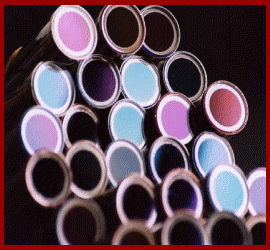| |||||||||||||||||||||||||||||||
 | Welcome to the "History of CCTV" Section | ||||||||||||||||||||||||||||||
 | |||||||||||||||||||||||||||||||
<< The faceplates of 2/3" 'Vidicon' camera tubes - circa 1980 | |||||||||||||||||||||||||||||||
These tubes were made in specific sizes, with one inch (faceplate diameter) being the standard during the early 1970’s, until 2/3” became the default standard for the late ‘70’s and ‘80’s. There was actually a brief attempt to mass market 1/2” cameras, but these were rapidly superseded by the emerging solid state technology imagers. Whilst the average Vidicon camera could provide really rather good pictures under ideal conditions, they were not without their problems. Apart from the weight and bulk penalties associated with the relatively large scan coil assemblies, the tubes themselves used to wear with age (and usage) and as such required regular recalibration and occasional replacement, to maintain a good quality picture. Certain chemical layers would also suffer from various ‘side effects’ such as ‘blooming’ (where a point of light would appear greatly enlarged on screen), ‘comet trailing’ (where a moving object would appear as a faint retained streaky image), and ‘burn in’ (where a fixed camera would eventually have a permanent image of its At their peak of production, hundreds of tubed varients were manufactured to fulfil an entire range of specialist applications, including ruggedised military use, Ultra Violet or X ray imaging, extreme low light Silicon Intensifier Tubes (SIT or ISIT), nuclear resistant devices and of course colour imaging. The earliest solid state ‘silicon chip’ imagers used MOS (Metal Oxide Semiconductor) technology devices to provide a relatively small and lightweight camera unit, with a less than spectacular performance; in fact, whilst most tube cameras could routinely resolve between 400 to 600 lines of detail, the resolution on the earliest ‘solid state’ cameras was only around 190 lines. | |||||||||||||||||||||||||||||||
 | |||||||||||||||||||||||||||||||
IMPORTANT: No material may be reproduced, copied or redistributed from this site, © doktorjon.co.uk 2004 - 2008 Homepage...:...Gateway...:...Technical Gateway....:....Quickfind Index....:....Equipment Directory | |||||||||||||||||||||||||||||||

